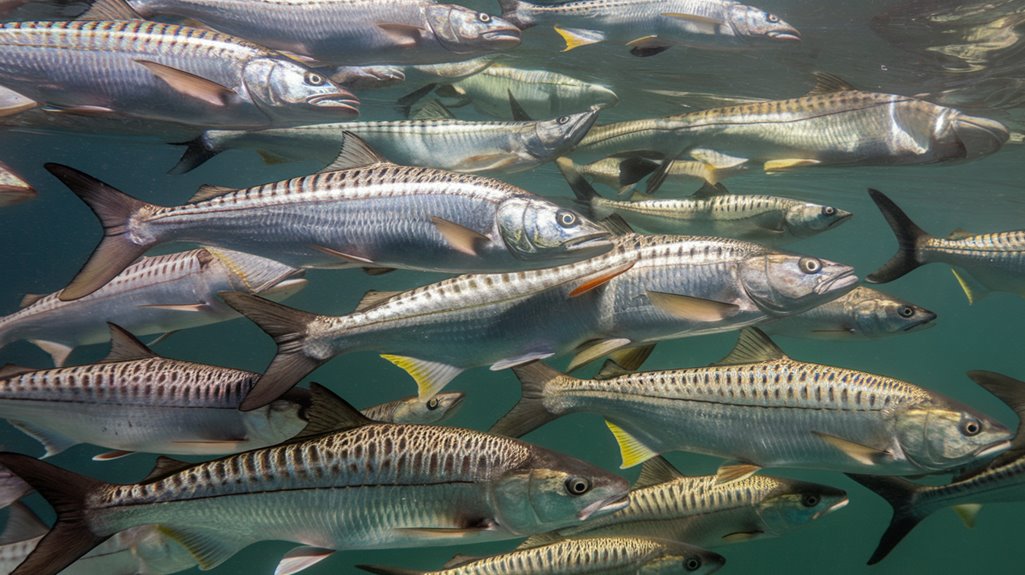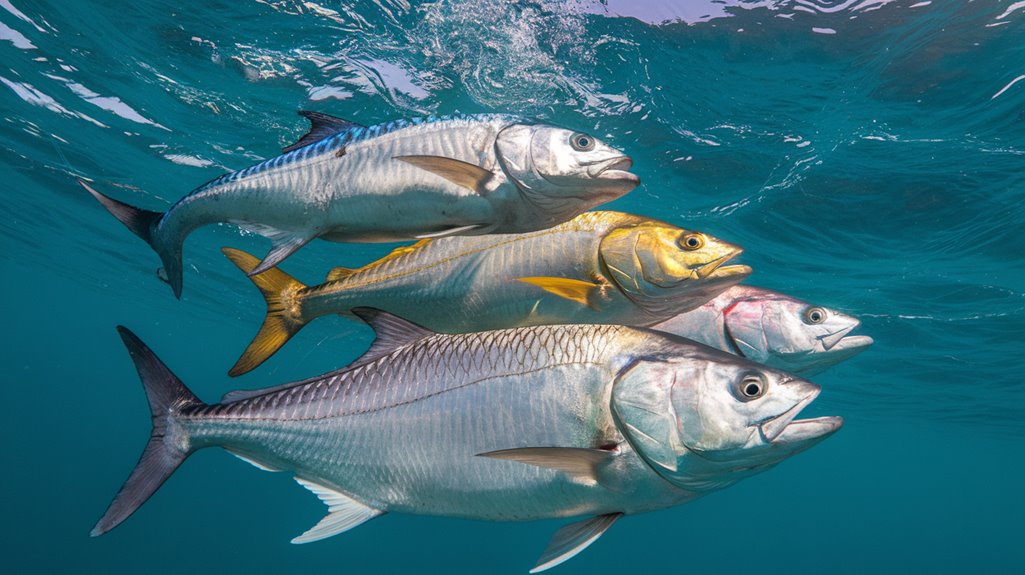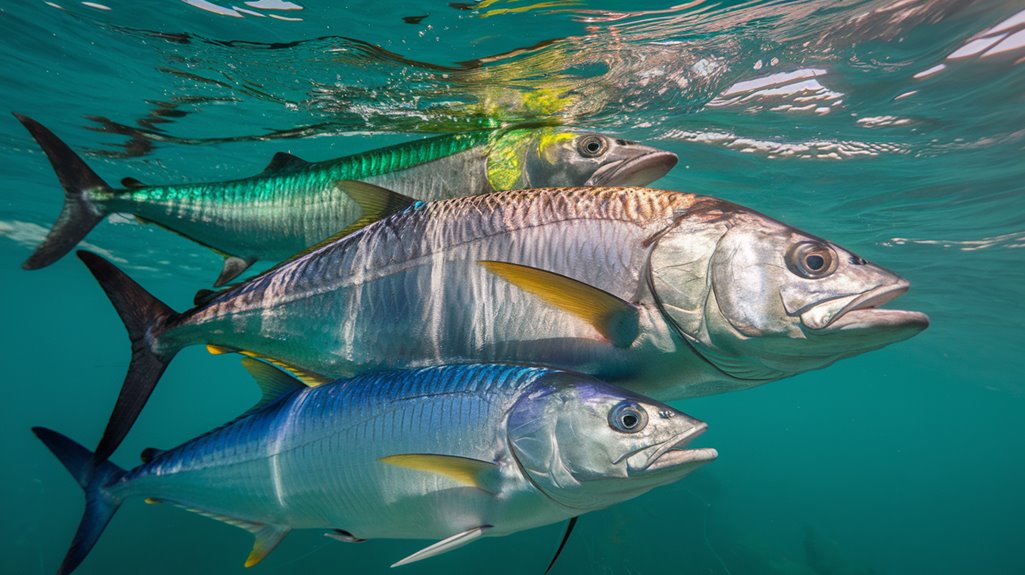You'll find that tarpon populations maintain unexpectedly high genetic diversity despite their wide geographic distribution across the Atlantic Ocean. Scientists have identified distinct genetic markers that suggest extensive gene flow between populations from Virginia to Brazil, challenging earlier assumptions about stock isolation. Through advanced DNA analysis techniques, researchers now track how ocean currents facilitate larval transport and genetic mixing across these vast distances, raising essential questions about population connectivity and conservation strategies.
- Key Takeaways
- Global Distribution Patterns of Tarpon DNA
- Genetic Markers and Population Structure
- Regional Connectivity Through Gene Flow
- Historical Evolution of Atlantic Stocks
- Impact of Ocean Currents on Genetic Mixing
- Spawning Behavior and Genetic Exchange
- Conservation Genetics and Management
- Molecular Analysis Methods and Results
- Trans-Atlantic Population Relationships
- Habitat Influences on Genetic Variation
- Migration Patterns and Genetic Diversity
- Research Implications for Species Protection
- Frequently Asked Questions
- Conclusion
Key Takeaways
- Genetic analysis of 23,000 scale samples reveals a single, well-connected Atlantic tarpon population extending from Virginia to Brazil.
- High levels of gene flow and consistent genetic profiles exist throughout the Western Atlantic range, indicating strong population mixing.
- Ocean currents facilitate extensive larval transport, promoting genetic exchange and maintaining diversity across the entire population range.
- African tarpon populations show significant genetic differentiation from Western Atlantic populations, with unique alleles and limited gene flow.
- Spawning behavior and adult migrations up to 1,700 km contribute to genetic mixing and maintain high diversity within populations.
Global Distribution Patterns of Tarpon DNA
While scientists previously believed tarpon existed in distinct regional populations, thorough genetic analysis of over 23,000 scale samples reveals a single, well-connected Atlantic population. You'll find consistent genetic profiles extending from Virginia to Brazil, with high levels of gene flow throughout the Atlantic region. The research demonstrates extensive connectivity among tarpon populations, facilitated by larval transport through ocean currents. Scale samples collected from Florida, the Caribbean Sea, and even the West African coast show remarkable genetic similarity, disproving earlier assumptions about separate stocks. These findings have significant implications for conservation efforts, as you'll need to take into account the entire Atlantic range when developing protection strategies. The high genetic diversity observed across locations emphasizes the importance of coordinated, cross-regional conservation approaches.
Genetic Markers and Population Structure
Using advanced molecular techniques like protein electrophoresis and mtDNA RFLP analysis, you'll find that Atlantic tarpon populations exhibit high genetic connectivity from Virginia to Brazil, functioning as a single interconnected stock. You can observe distinct genetic variations in African populations through unique alleles and haplotypes, which clearly differentiate them from Western Atlantic specimens. Costa Rican tarpon populations show lower genetic relatedness compared to other Western Atlantic groups, indicating partial isolation and distinct population structure within this region.
DNA Sampling Methods Analysis
Through thorough molecular genetic analysis, researchers examined tarpon population structures using both protein electrophoresis of nuclear DNA and mtDNA restriction fragment length polymorphism techniques. Their extensive DNA sampling methods included collecting over 23,000 scale samples globally, enabling an extensive assessment of genetic variation in tarpon populations across the Atlantic region.
The analysis revealed significant differences in allozyme allele and mtDNA haplotype frequencies between African and western Atlantic populations. FST analyses highlighted distinct genetic differentiation, with unique alleles present in specific geographic areas like Costa Rica. AMOVA results demonstrated genetic relatedness among western Atlantic collections, while the observed variations between regions indicated limited gene flow. These findings provide vital insights for developing targeted conservation strategies based on population-specific genetic markers.
Population Connectivity Patterns
Recent genetic analyses have reshaped our understanding of tarpon population structures, contradicting earlier hypotheses of distinct regional stocks. You'll find that advanced molecular techniques, including protein electrophoresis and mtDNA RFLP analysis, reveal extensive gene flow throughout the Atlantic region.
The Atlantic Tarpon exhibits remarkable genetic connectivity, spanning from Virginia to Brazil and even reaching West African waters. This population genetic structure is maintained through two key mechanisms: adult migrations extending up to 1700 km and ocean currents dispersing larvae across vast distances. The discovery of shared genetic traits between Western Atlantic and West African specimens confirms trans-Atlantic connectivity. These findings emphasize that effective conservation efforts must shift from localized approaches to coordinated international strategies, as you're dealing with a single, highly connected population rather than isolated stocks.
Regional Genetic Variations Identified
While Atlantic tarpon populations exhibit broad connectivity patterns, molecular analysis has revealed distinct regional genetic variations that challenge the simplistic view of a uniform population structure. You'll find significant genetic differentiation between African and western Atlantic populations, with unique alleles and haplotypes characterizing African specimens. Gene flow analysis indicates limited exchange between these major regions, while Costa Rican populations demonstrate partial isolation from other western Atlantic groups. Allozyme studies reveal notable differences in regional allele frequencies, suggesting local adaptations within distinct populations. The molecular genetic variation data highlights the complexity of tarpon population dynamics, where western Atlantic collections maintain shared genetic diversity yet display significant FST values, indicating varying degrees of connectivity among regional populations.
Regional Connectivity Through Gene Flow
Studies of Atlantic tarpon populations reveal extensive genetic connectivity across vast oceanic regions, with DNA analyses confirming a single distinct population from Virginia to Brazil. You'll find remarkable trans-Atlantic connectivity between Western Atlantic and West African populations, demonstrating significant gene flow between tarpon populations.
| Region | Connectivity Factor |
|---|---|
| Atlantic Coast | 1,700km migration range |
| Caribbean | Larval transport currents |
| West Africa | Shared genetic markers |
| Brazil | Population intermixing |
The Atlantic Tarpon (Megalops atlanticus) maintains genetic diversity through two primary mechanisms: adult migration capabilities and larval dispersal via ocean currents. This extensive population connectivity necessitates coordinated conservation strategies across international boundaries. Current research indicates that you're looking at one of the most well-connected marine species in the Atlantic basin, with implications for regional fisheries management.
Historical Evolution of Atlantic Stocks

The scientific understanding of Atlantic tarpon stocks has evolved markedly from early population theories that proposed two distinct genetic stocks. You'll find that initial studies, such as McMillen-Jackson's 2005 research, supported this dual-stock hypothesis based on preliminary genetic markers and regional distribution patterns. Modern genetic analyses have revolutionized this perspective, with BTT and FWC's thorough study revealing a single, highly connected population structure throughout the western Atlantic region.
Early Population Theories
Prior to recent genomic advancements, scientific understanding of Atlantic tarpon populations relied heavily on preliminary genetic studies that suggested a bifurcated stock structure. You'll find that McMillen-Jackson's 2005 research initially proposed two distinct Atlantic tarpon populations, a theory that shaped early conservation approaches. However, this perspective didn't withstand the test of more sophisticated genetic analysis. The thorough BTT study, examining over 23,000 scale samples, revealed a single, genetically connected population extending from Virginia to West Africa. This discovery of extensive gene flow across the Atlantic basin has transformed our understanding of tarpon population structure. The evolution from a dual-stock theory to a unified population model demonstrates how advancing genetic research techniques continue to refine conservation strategies for this species.
Geographic Stock Shifts
Understanding geographic stock shifts in Atlantic tarpon populations has evolved dramatically since initial research efforts began. You'll find that early genetic studies, including McMillen-Jackson's 2005 work, initially pointed to two distinct Atlantic tarpon stocks. However, BTT's extensive analysis of 23,000 scale samples has revolutionized this understanding, revealing just one highly connected population. The genetic profile shows remarkable consistency from Virginia to Brazil, with genetic markers even matching West African specimens. This unified population structure is maintained through adult tarpon migrations spanning up to 1,700 km and larval dispersal via ocean currents. These findings have significant implications for management strategies, as they demonstrate that effective conservation must address the entire Atlantic range rather than isolated regional populations.
Modern Genetic Understanding
While early genetic research initially pointed to separate Atlantic tarpon stocks, modern DNA analysis has fundamentally transformed our understanding of their population structure. The thorough BTT study, analyzing over 23,000 scale samples, revealed a single, genetically interconnected Atlantic tarpon population. Advanced techniques like protein electrophoresis and mtDNA RFLP analysis demonstrated substantial gene flow between populations from Virginia to Brazil, including West African specimens. You'll find that ocean currents play an essential role in larval dispersal, contributing to genetic diversity across vast distances. This new understanding of tarpon as one unified population, rather than distinct stocks, highlights the necessity for international cooperation in conservation efforts. The evidence shows remarkable genetic connectivity spanning the entire Atlantic region.
Impact of Ocean Currents on Genetic Mixing

Ocean currents serve as essential biological highways for tarpon populations, orchestrating complex patterns of genetic exchange across the Atlantic region. You'll find that these currents facilitate gene flow by transporting tarpon larvae through step-wise dispersal patterns, from the Caribbean to the Gulf of Mexico. This movement considerably impacts genetic diversity within tarpon populations.
| Current System | Direction | Impact on Gene Flow |
|---|---|---|
| Caribbean | Northwest | Larval transport to Belize |
| Gulf Stream | Northeast | Florida population mixing |
| Atlantic | Circular | Cross-regional exchange |
| Coastal | Multi-directional | Local population connectivity |
The extensive migration capabilities of adult tarpon, combined with larval dispersal via ocean currents, create a highly connected genetic network. This connectivity maintains genetic mixing across distances up to 1700 km, resulting in a single, genetically diverse Atlantic stock.
Spawning Behavior and Genetic Exchange
Because spawning patterns directly influence genetic diversity, tarpon's reproductive behavior plays an essential role in maintaining population connectivity across the Atlantic region. Gene flow occurs through two primary mechanisms: adult migrations and larval dispersal from offshore spawning grounds.
- Migratory pathways extend up to 1,700 km, enabling genetic exchange between populations from Virginia to Brazil
- Spawning behavior occurs in offshore waters, where ocean currents transport larvae across vast distances
- Genetic studies confirm high levels of gene flow, resulting in shared genetic profiles throughout the species' range
- Recapture data from Florida, Alabama, and Louisiana validates the extensive movement patterns that facilitate genetic mixing
This dual-mechanism approach to genetic exchange guarantees robust genetic diversity within tarpon populations, emphasizing the necessity of protecting both spawning sites and juvenile habitats.
Conservation Genetics and Management
You'll find that Atlantic tarpon's high genetic connectivity across ocean basins creates complex conservation challenges, requiring coordinated international management strategies from Virginia to Brazil. Protection of juvenile habitats, particularly mangroves, becomes critical when you consider the species' slow maturation rate and the genetic evidence of population mixing. Your conservation efforts must account for how unregulated fishing in one region can impact tarpon populations throughout their range, as genetic data shows downstream effects of local harvesting practices.
Population Connectivity Challenges
While tarpon populations demonstrate remarkable genetic connectivity across the Atlantic basin, this widespread distribution presents unique challenges for conservation management. The high gene flow between populations, spanning from Virginia to Brazil and West Africa, creates complex interdependencies that require coordinated conservation efforts.
Key population connectivity challenges include:
- Long-distance migrations of up to 1700 km complicate tracking and protecting adult tarpon across jurisdictional boundaries
- Larval dispersal via ocean currents creates step-wise genetic diversity patterns that demand multi-regional protection strategies
- Unregulated harvest in one region can notably impact down-current populations due to their interconnected nature
- Critical juvenile habitats, particularly mangroves, require protection across the entire range to maintain genetic diversity and population resilience
These factors necessitate an integrated, transboundary approach to tarpon conservation management.
Habitat Protection Priorities
Given the genetic connectivity of Atlantic tarpon populations, establishing strategic habitat protection priorities emerges as a critical conservation imperative. You'll find that effective management strategies must address both spawning grounds and juvenile habitats across the species' extensive range from Virginia to Brazil.
To maintain genetic diversity, conservation efforts should focus on protecting mangrove ecosystems where juvenile tarpon develop. You'll need to implement coordinated regional regulations, as uncontrolled harvesting in one area can impact populations up to 1700 km away. The species' slow maturation rate means you must prioritize habitat conservation to support population recovery. By safeguarding these critical areas through cross-jurisdictional cooperation, you're ensuring the long-term survival of this vulnerable species throughout its interconnected range.
Molecular Analysis Methods and Results
Through extensive molecular analysis, scientists employed multiple genetic techniques to evaluate population diversity in Atlantic tarpon (Megalops atlanticus). Research findings revealed significant genetic structuring between African and western Atlantic populations through allozyme allele frequencies and mtDNA haplotype analysis.
Key molecular findings include:
- Distinct genetic differentiation between African and western Atlantic populations
- Unique alleles and haplotypes identified in African populations
- Limited gene flow between major geographical regions
- Partial isolation of Costa Rican populations from other western Atlantic groups
The results of protein electrophoresis and mtDNA RFLP analysis demonstrate clear population structuring, highlighting the effectiveness of molecular techniques in revealing genetic diversity patterns. This genetic data provides essential insights for developing targeted conservation strategies and managing distinct tarpon populations across their geographic range.
Trans-Atlantic Population Relationships
Recent molecular analyses have revealed a more nuanced understanding of trans-Atlantic tarpon population dynamics than previously theorized. You'll find that gene flow patterns indicate a single, cohesive population stretching from Virginia to Brazil, contradicting earlier hypotheses of distinct stocks. The data demonstrates significant trans-Atlantic connectivity between West African and western Atlantic populations through genetic markers.
| Population Characteristic | Finding |
|---|---|
| Geographic Range | Virginia to Brazil |
| Population Structure | Single unified stock |
| Migration Distance | Up to 1700 km |
| Larval Transport | Via warm currents |
| Genetic Exchange | Trans-Atlantic |
Adult tarpon's extensive migratory capabilities, combined with larval transport via ocean currents, maintain genetic diversity across the Atlantic. This connectivity creates a robust population structure that's more integrated than scientists previously understood, highlighting the species' remarkable ability to maintain genetic exchange across vast oceanic distances.
Habitat Influences on Genetic Variation
While ocean currents facilitate larval transport across vast distances, local habitat characteristics play an essential role in shaping tarpon genetic variation. You'll find that habitat-specific factors influence gene flow patterns throughout their life stages.
- Mangrove ecosystems serve as primary nursery grounds, directly impacting juvenile survival and genetic diversity maintenance
- Environmental conditions, particularly salinity gradients, affect population distribution and subsequent genetic structuring
- Long-distance migrations of up to 1700 km enable substantial gene flow between geographically distinct habitats
- Habitat quality in coastal areas influences recruitment success and genetic mixing potential
The interconnected nature of these habitat influences demonstrates why preserving diverse environmental conditions, especially mangrove systems, is vital for maintaining robust genetic diversity within tarpon populations. You'll need to take into account these habitat-genetic relationships when developing effective conservation strategies.
Migration Patterns and Genetic Diversity
As tarpon populations traverse vast oceanic distances, their migration patterns greatly influence genetic diversity throughout their range. You'll find Atlantic tarpon exhibiting remarkable gene flow across populations, with individuals traveling up to 1700 km during migrations. These extensive movements create shared genetic profiles from Virginia to Brazil, while larval dispersal via ocean currents further enhances connectivity.
You'll notice that some populations, like those in Costa Rica, maintain unique alleles despite this connectivity, indicating partial isolation. This complex pattern of genetic diversity requires careful management through international cooperation. The extensive migration patterns you're observing directly impact population genetics, making it essential to coordinate conservation efforts across jurisdictions to maintain healthy gene flow and preserve the species' genetic diversity throughout its range.
Research Implications for Species Protection
Genetic research findings on tarpon populations have revolutionized our understanding of their conservation needs. The discovery of high gene flow among Atlantic tarpon populations from Virginia to Brazil indicates that conservation strategies must be coordinated across international boundaries.
Key implications for species protection:
- Shared genetic structure requires multinational management approaches spanning the Western Atlantic
- Distinct African populations necessitate separate conservation protocols from Western Atlantic stocks
- High connectivity demands synchronized habitat protection efforts across jurisdictions
- Juvenile habitat preservation, particularly mangroves, is essential for population sustainability
The research emphasizes that you can't effectively protect these vulnerable species through isolated efforts. Instead, conservation success depends on implementing cohesive management strategies that account for both the species' genetic connectivity and their specific habitat requirements throughout their range.
Frequently Asked Questions
What Is Genetic Diversity Within a Population?
You'll find genetic diversity represents the total number of genetic characteristics within a species' genome, enabling populations to adapt through varied alleles and genetic combinations.
What Are Populations With Little Genetic Diversity More Likely to Do?
You'll observe that populations with low genetic diversity experience increased inbreeding, accumulate deleterious traits, show reduced adaptability to environmental changes, and face higher extinction risks due to compromised fitness.
Conclusion
You'll find that tarpon populations, like an intricate web of genetic threads, weave across the Atlantic through invisible oceanic highways. The DNA markers you're tracking reveal a complex tapestry of gene flow, where larvae drift like microscopic voyagers between Virginia and Brazil. Your research demonstrates how these marine nomads maintain remarkable genetic diversity through precise spawning synchronicity and strategic habitat utilization, forming a unified meta-population that's critical for species resilience.

